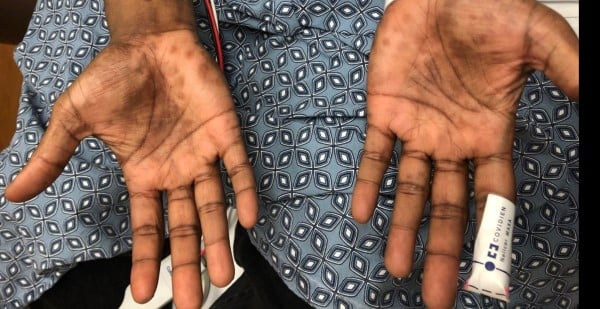We present the case of a patient with a rash, uveitis, and neurosyphilis.
Our patient, a 37-year-old male with a history of Crohn's disease, presented to the emergency department with a headache, uveitis recognized during an outpatient ophthalmology appointment, and a recent diagnosis of syphilis.
The patient previously had complained of a rash for several months that initially was attributed to a drug reaction; however, when it failed to improve, further testing was performed, and he was found to have syphilis. The patient had a positive rapid plasma reagin (RPR) during an outpatient visit 1 week prior to presentation to the ED and had been treated with 1 dose of intramuscular penicillin.
In the ED, non-contrast CT of the head was performed with no evidence of acute abnormality of the brain. A lumbar puncture was performed; grossly clear fluid was obtained and sent for further testing. The decision was made to start intravenous penicillin with concern for neurosyphilis, given the constellation of symptoms.
Discussion
According to the CDC, cases of syphilis nationwide have been on the rise since 2000. In 2020, 133,945 cases were reported, approximately one-third of which were primary and secondary syphilis, the most infectious stages of the disease.
Syphilis is more commonly seen in men than women, and 38% of reported cases are in men who have sex with men (MSM).1 The highest rates of primary and secondary syphilis occur in the 25-29 year old age group.1 People at highest risk include the MSM population, and men or women living with HIV. Syphilis has often been called “The Great Masquerader” because the symptoms are nonspecific at times, and it is likely that syphilis is underdiagnosed because of this.2
Primary syphilis classically presents as a painless genital ulcer that appears approximately 2-3 weeks after exposure, and patients often develop regional firm lymphadenopathy.3 Without treatment, these symptoms typically resolve in 3-8 weeks; however, if untreated, hematogenous spread of treponema pallidum can occur, leading to secondary syphilis.3
Symptoms of secondary syphilis can be rather non-specific and include general malaise, fevers, and a widely variable body rash. The rash is typically nonpruritic in any combination of macular, papular, or pustular lesions involving the chest, back, palms, and soles; alopecia; or mucus patches.2

Tertiary syphilis is the rarest form because of screening and treatment for earlier stages. It most often includes gummatous lesions, cardiovascular syphilis, and late neurosyphilis, and may present as general paresis, tabes dorsalis, or with psychiatric manifestations.3
Neurosyphilis can occur at any stage of syphilis and can be characterized as early or late neurosyphilis, and ocular and otic involvement may occur in either early or late infection.3 Ocular syphilis most commonly presents as uveitis in any form, but you may also find episcleritis, retinitis or optic neuritis.4 Otosyphilis usually presents with hearing loss, tinnitus, or vertigo. In patients with suspected ocular or otosyphilis, examination by the respective specialist should be performed, and lumbar puncture should be considered if there is any concern for neurosyphilis.5 Additionally, lumbar puncture should be performed if there is any cranial nerve abnormality. The diagnostic test is the venereal disease research laboratory (VDRL) test in the cerebrospinal fluid (CSF).3
Parenteral penicillin G is recommended and efficacious for primary and secondary syphilis, and for preventing late sequelae. The recommended regimen among adults is a single dose of benzathine penicillin G 2.4 million units IM.6
In patients with neurosyphilis, ocular syphilis, and/or otosyphilis, the recommended treatment regimen is aqueous crystalline penicillin G 18-24 million units per day, administered as 3-4 million units IV every 4 hours or continuous infusion for 10-14 days.6 A proposed alternative treatment can be considered if compliance with therapy can be ensured: procaine penicillin G 2.4 million units IM once daily plus probenecid 500 mg orally 4 times per day, each for 10-14 days.6
Case Conclusion
The patient was diagnosed with tertiary syphilis with CSF VDRL that was positive in the hospital and continued on IV penicillin. During his hospital stay, he was also found to have chlamydia and subsequently completed a course of doxycycline.
Take-Home Points
- New cases of syphilis are on the rise, so have a high index of suspicion in patients with any risk factor or symptoms.
- Consider neurosyphilis in patients with prior history of syphilis and any headache, vision or hearing changes, or neurologic deficits.
- Syphilis is commonly diagnosed in conjunction with other sexually transmitted diseases, so screen widely in patients with risk factors.
References
- Centers for Disease Control and Prevention. (2022, April 12). Syphilis statistics - STD information from CDC. Centers for Disease Control and Prevention. Retrieved March 13, 2023, from https://www.cdc.gov/std/syphilis/stats.htm
- Ashraf, R., Mahajan, R., Chatterjee, D., & Arpitha, K. (2021). Revisiting the ‘Great Masquerader.’ Cleveland Clinic Journal of Medicine, 88(10), 536–537. https://doi.org/10.3949/ccjm.88a.20203
- Spach, D. H., & Ramchandani, M. S. (n.d.). Syphilis. National STD Curriculum. Retrieved March 14, 2023, from https://www.std.uw.edu/go/comprehensive-study/syphilis/core-concept/all
- Spoor TC, Wynn P, Hartel WC, Bryan CS. Ocular syphilis. Acute and chronic. J Clin Neuroophthalmol. 1983 Sep;3(3):197-203. PMID: 6226720.
- Centers for Disease Control and Prevention. (2021, July 22). STI treatment guidelines. Centers for Disease Control and Prevention. Retrieved March 13, 2023, from https://www.cdc.gov/std/treatment-guidelines/default.htm
- Workowski KA, Bachmann LH, Chan PA, Johnston CM, Muzny CA, Park I, Reno H, Zenilman JM, Bolan GA. Sexually Transmitted Infections Treatment Guidelines, 2021. MMWR Recomm Rep. 2021 Jul 23;70(4):1-187. doi: 10.15585/mmwr.rr7004a1. PMID: 34292926; PMCID: PMC8344968.



